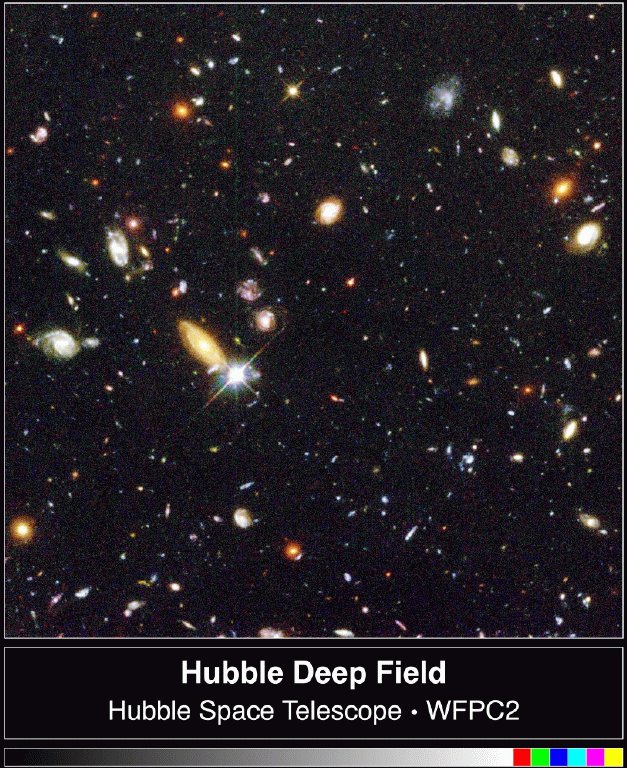Do you truly comprehend how huge the universe is? Don't bother saying yes. The human mind is simply not capable of comprehending the immensity of the universe. However, it IS possible to get a BETTER perspective on how big the universe is.
The image at the bottom of this page comes from the Hubble Space Telescope. This image is called the Hubble Deep Field.
Alright, here's the part where you're supposed to gain a better perspective:
- Imagine a dime that is 75 feet away from you. Better yet, place a dime on something, walk 75 feet away from it, and look and see how small it is.
- Now look up into the sky and imagine that dime 75 feet away (up in the sky).
- Here's the kicker. Imagine that there are 1500 galaxies in that little spot of sky. The image at the bottom of this page is exactly that. It is an image of a piece of sky which is the size of a dime held 75 feet away. In that image are roughly 1500 galaxies.
Hopefully, if you've really thought these steps through, you'll be filled with a quiet sense of wonderment. Just think, in that tiny slice of sky are 1500 galaxies! Not 1500 stars, 1500 galaxies! Each galaxy is composed of between hundreds of million to more than a trillion stars! How many 75FADSS (from now on I'll use the abbreviation 75FADSS to stand for 75 Feet Away Dime Sky Slice) do you suppose it would take to cover the entire sky?
Furthermore, all those stars are extremely far apart and the galaxies
even farther apart. Here's a few tidbits of info that should give you
even better perspective on how big the universe is:
Distance to the Sun (at perihelion) = 91,400,000 miles
Speed of Light = 670,615,200 miles per hour
One light year = 5,874,589,152,000 miles
Years to Sun at 60 Miles per Hour = about 173 years
Distance to Proxima Centauri = 25,260,733,354,000 miles
Light Years to Proxima Centauri = 4.3 light years
Seconds to Proxima Centauri = 135,604,800 s. (at speed of light)
Hours to Proxima Centauri = 37,668 hours (at speed of light)
Days to Proxima Centauri = 1569.5 days (at speed of light)
Years to Proxima Centauri at 60MPH = 48,060,756
Distance to nearest Galaxy = 1,174,917,830,400,000,000 miles
Light Years to nearest Galaxy = 200,000 light years
Seconds to nearest Galaxy = 6,307,200,000,000 (at light speed)
Hours to nearest Galaxy = 1,752,000,000 (at light speed)
Days to nearest Galaxy = 73,000,000 (at light speed)
Years to nearest Galaxy at 60MPH = 2,235,384,000,000

The image, and some of the corresponding information, originally comes
from the Hubble
Deep Field page on the SEDS' (Students
for the Exploration and Development of Space) site.